Stress and Conflict Management in Schools: Strategies and Approaches
VerifiedAdded on 2023/01/12
|13
|3127
|26
Essay
AI Summary
This paper delves into the critical topics of stress and conflict management within the context of educational institutions. It begins by defining key terms such as conflict, conflict management, stress, and stress management, setting the stage for an in-depth discussion. The paper explores both traditional and modern approaches to conflict resolution, highlighting the shift towards incorporating Conflict Management Systems (CMS) in organizations. It examines the impact of stress on students, particularly freshmen, and suggests coping mechanisms like social interaction and extracurricular activities. Furthermore, the paper analyzes the roles of leadership, culture, and communication in conflict management, emphasizing the importance of adapting strategies to diverse environments. It also addresses the specific challenges of conflict in secondary schools, such as bullying, and the need for educating students on conflict and violence. The paper then focuses on the relationship between Emotional Intelligence (EI), self-leadership, and stress coping, presenting a model for managing student stress through journaling. Finally, it touches upon conflict management from an Islamic perspective and proposes techniques for medical students to cope with stress. The paper concludes by summarizing the key theories related to conflict and stress management, including cognitive and self-regulation theories, underscoring the importance of informed decision-making and emotional control in resolving disputes.
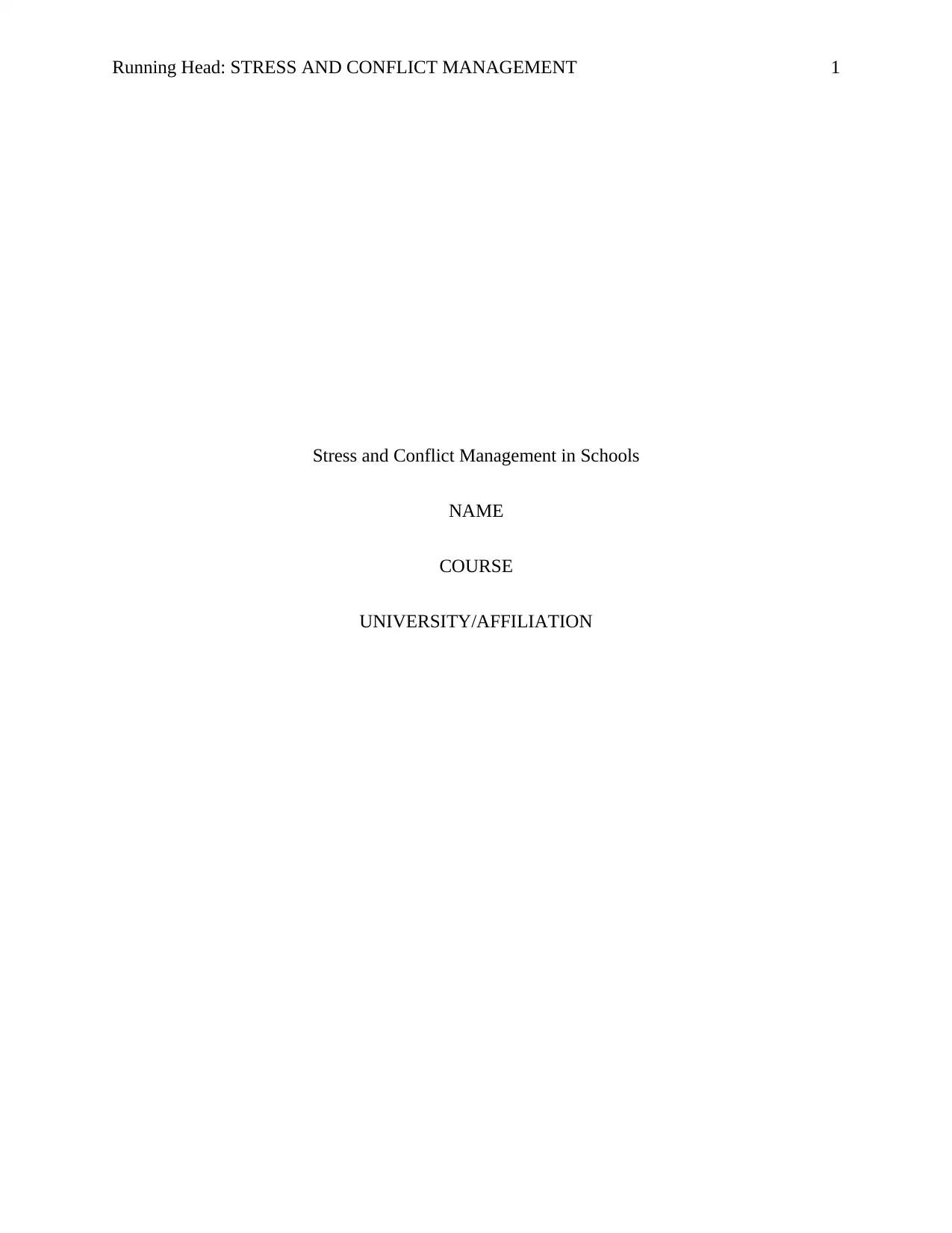
Running Head: STRESS AND CONFLICT MANAGEMENT 1
Stress and Conflict Management in Schools
NAME
COURSE
UNIVERSITY/AFFILIATION
Stress and Conflict Management in Schools
NAME
COURSE
UNIVERSITY/AFFILIATION
Paraphrase This Document
Need a fresh take? Get an instant paraphrase of this document with our AI Paraphraser
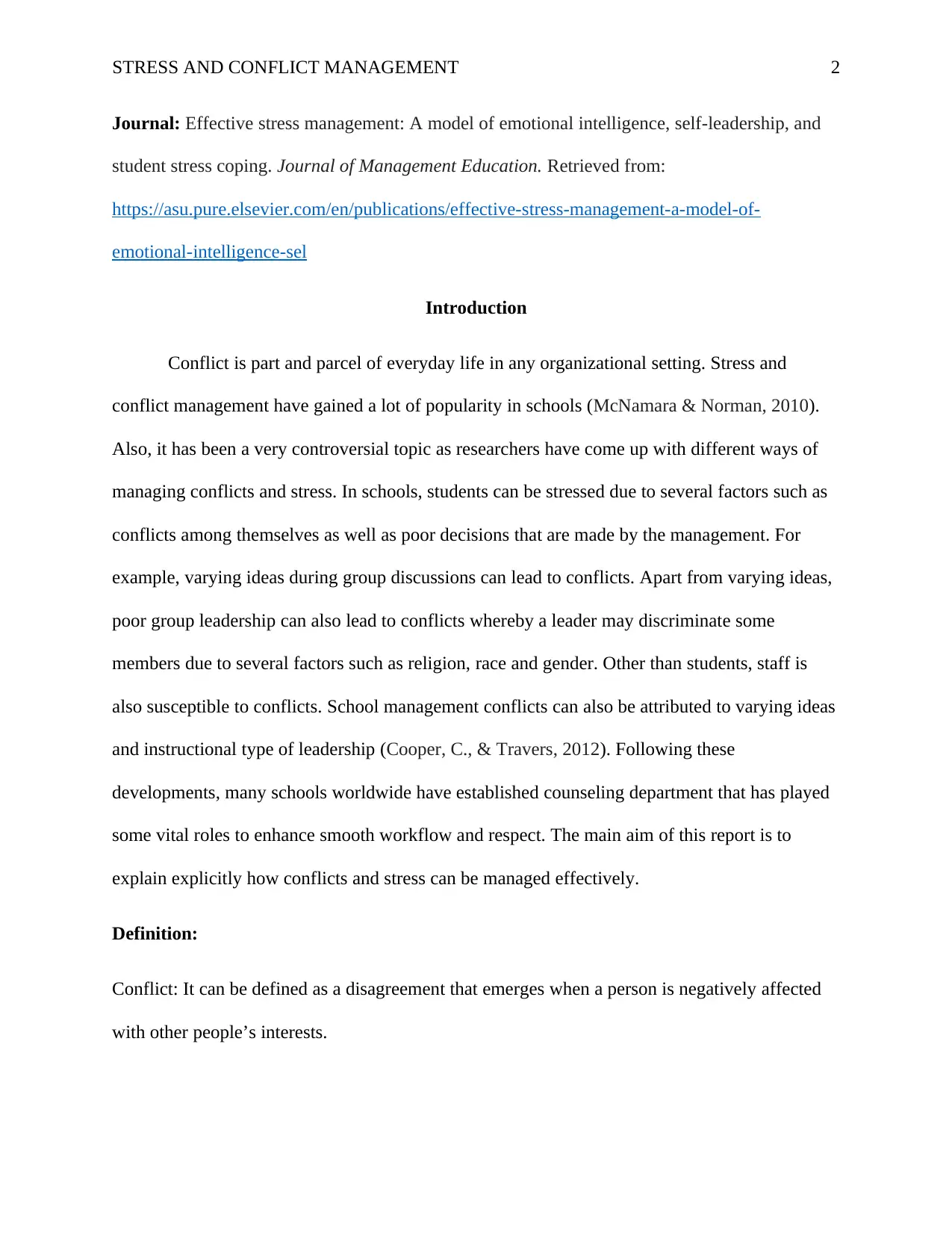
STRESS AND CONFLICT MANAGEMENT 2
Journal: Effective stress management: A model of emotional intelligence, self-leadership, and
student stress coping. Journal of Management Education. Retrieved from:
https://asu.pure.elsevier.com/en/publications/effective-stress-management-a-model-of-
emotional-intelligence-sel
Introduction
Conflict is part and parcel of everyday life in any organizational setting. Stress and
conflict management have gained a lot of popularity in schools (McNamara & Norman, 2010).
Also, it has been a very controversial topic as researchers have come up with different ways of
managing conflicts and stress. In schools, students can be stressed due to several factors such as
conflicts among themselves as well as poor decisions that are made by the management. For
example, varying ideas during group discussions can lead to conflicts. Apart from varying ideas,
poor group leadership can also lead to conflicts whereby a leader may discriminate some
members due to several factors such as religion, race and gender. Other than students, staff is
also susceptible to conflicts. School management conflicts can also be attributed to varying ideas
and instructional type of leadership (Cooper, C., & Travers, 2012). Following these
developments, many schools worldwide have established counseling department that has played
some vital roles to enhance smooth workflow and respect. The main aim of this report is to
explain explicitly how conflicts and stress can be managed effectively.
Definition:
Conflict: It can be defined as a disagreement that emerges when a person is negatively affected
with other people’s interests.
Journal: Effective stress management: A model of emotional intelligence, self-leadership, and
student stress coping. Journal of Management Education. Retrieved from:
https://asu.pure.elsevier.com/en/publications/effective-stress-management-a-model-of-
emotional-intelligence-sel
Introduction
Conflict is part and parcel of everyday life in any organizational setting. Stress and
conflict management have gained a lot of popularity in schools (McNamara & Norman, 2010).
Also, it has been a very controversial topic as researchers have come up with different ways of
managing conflicts and stress. In schools, students can be stressed due to several factors such as
conflicts among themselves as well as poor decisions that are made by the management. For
example, varying ideas during group discussions can lead to conflicts. Apart from varying ideas,
poor group leadership can also lead to conflicts whereby a leader may discriminate some
members due to several factors such as religion, race and gender. Other than students, staff is
also susceptible to conflicts. School management conflicts can also be attributed to varying ideas
and instructional type of leadership (Cooper, C., & Travers, 2012). Following these
developments, many schools worldwide have established counseling department that has played
some vital roles to enhance smooth workflow and respect. The main aim of this report is to
explain explicitly how conflicts and stress can be managed effectively.
Definition:
Conflict: It can be defined as a disagreement that emerges when a person is negatively affected
with other people’s interests.
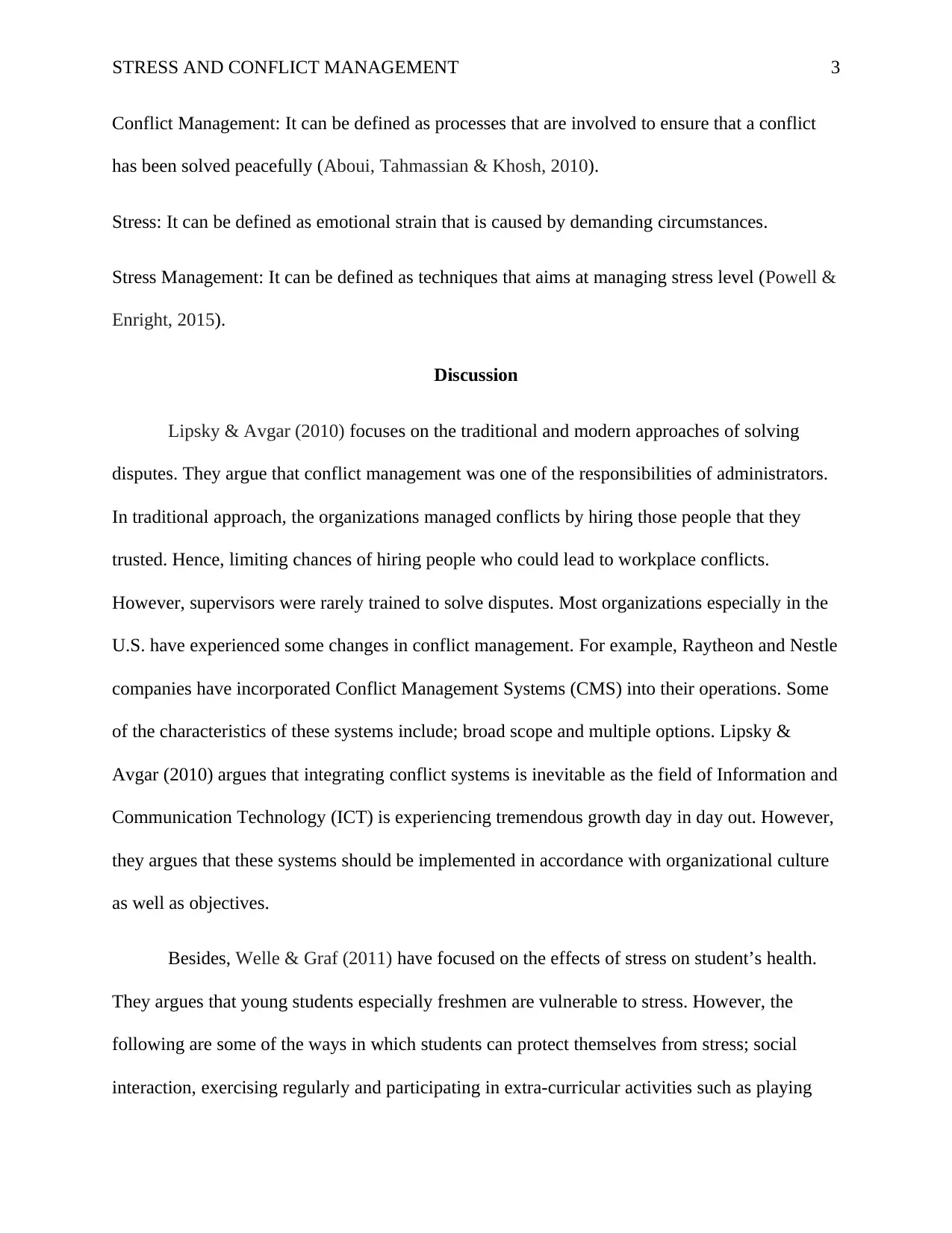
STRESS AND CONFLICT MANAGEMENT 3
Conflict Management: It can be defined as processes that are involved to ensure that a conflict
has been solved peacefully (Aboui, Tahmassian & Khosh, 2010).
Stress: It can be defined as emotional strain that is caused by demanding circumstances.
Stress Management: It can be defined as techniques that aims at managing stress level (Powell &
Enright, 2015).
Discussion
Lipsky & Avgar (2010) focuses on the traditional and modern approaches of solving
disputes. They argue that conflict management was one of the responsibilities of administrators.
In traditional approach, the organizations managed conflicts by hiring those people that they
trusted. Hence, limiting chances of hiring people who could lead to workplace conflicts.
However, supervisors were rarely trained to solve disputes. Most organizations especially in the
U.S. have experienced some changes in conflict management. For example, Raytheon and Nestle
companies have incorporated Conflict Management Systems (CMS) into their operations. Some
of the characteristics of these systems include; broad scope and multiple options. Lipsky &
Avgar (2010) argues that integrating conflict systems is inevitable as the field of Information and
Communication Technology (ICT) is experiencing tremendous growth day in day out. However,
they argues that these systems should be implemented in accordance with organizational culture
as well as objectives.
Besides, Welle & Graf (2011) have focused on the effects of stress on student’s health.
They argues that young students especially freshmen are vulnerable to stress. However, the
following are some of the ways in which students can protect themselves from stress; social
interaction, exercising regularly and participating in extra-curricular activities such as playing
Conflict Management: It can be defined as processes that are involved to ensure that a conflict
has been solved peacefully (Aboui, Tahmassian & Khosh, 2010).
Stress: It can be defined as emotional strain that is caused by demanding circumstances.
Stress Management: It can be defined as techniques that aims at managing stress level (Powell &
Enright, 2015).
Discussion
Lipsky & Avgar (2010) focuses on the traditional and modern approaches of solving
disputes. They argue that conflict management was one of the responsibilities of administrators.
In traditional approach, the organizations managed conflicts by hiring those people that they
trusted. Hence, limiting chances of hiring people who could lead to workplace conflicts.
However, supervisors were rarely trained to solve disputes. Most organizations especially in the
U.S. have experienced some changes in conflict management. For example, Raytheon and Nestle
companies have incorporated Conflict Management Systems (CMS) into their operations. Some
of the characteristics of these systems include; broad scope and multiple options. Lipsky &
Avgar (2010) argues that integrating conflict systems is inevitable as the field of Information and
Communication Technology (ICT) is experiencing tremendous growth day in day out. However,
they argues that these systems should be implemented in accordance with organizational culture
as well as objectives.
Besides, Welle & Graf (2011) have focused on the effects of stress on student’s health.
They argues that young students especially freshmen are vulnerable to stress. However, the
following are some of the ways in which students can protect themselves from stress; social
interaction, exercising regularly and participating in extra-curricular activities such as playing
⊘ This is a preview!⊘
Do you want full access?
Subscribe today to unlock all pages.

Trusted by 1+ million students worldwide
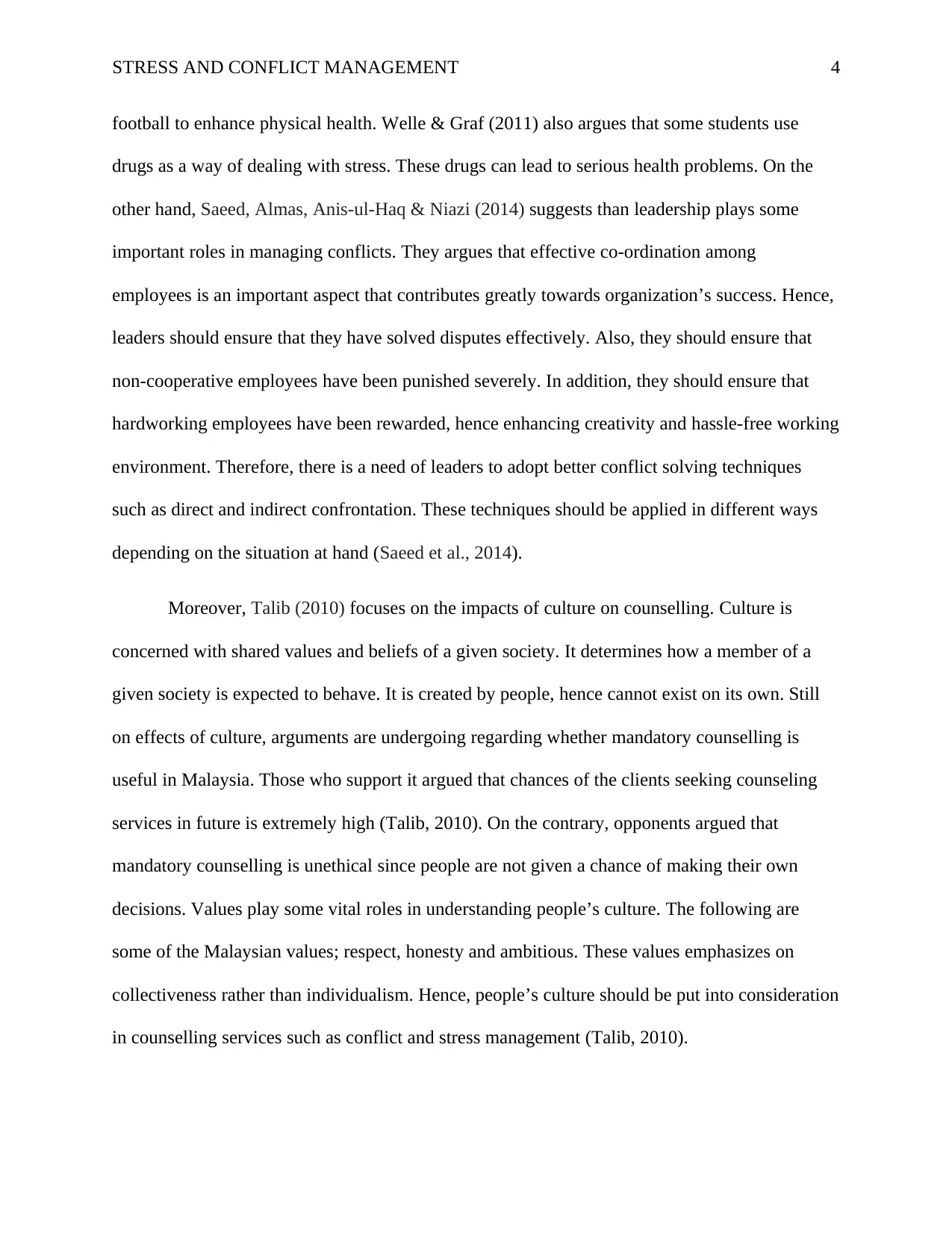
STRESS AND CONFLICT MANAGEMENT 4
football to enhance physical health. Welle & Graf (2011) also argues that some students use
drugs as a way of dealing with stress. These drugs can lead to serious health problems. On the
other hand, Saeed, Almas, Anis-ul-Haq & Niazi (2014) suggests than leadership plays some
important roles in managing conflicts. They argues that effective co-ordination among
employees is an important aspect that contributes greatly towards organization’s success. Hence,
leaders should ensure that they have solved disputes effectively. Also, they should ensure that
non-cooperative employees have been punished severely. In addition, they should ensure that
hardworking employees have been rewarded, hence enhancing creativity and hassle-free working
environment. Therefore, there is a need of leaders to adopt better conflict solving techniques
such as direct and indirect confrontation. These techniques should be applied in different ways
depending on the situation at hand (Saeed et al., 2014).
Moreover, Talib (2010) focuses on the impacts of culture on counselling. Culture is
concerned with shared values and beliefs of a given society. It determines how a member of a
given society is expected to behave. It is created by people, hence cannot exist on its own. Still
on effects of culture, arguments are undergoing regarding whether mandatory counselling is
useful in Malaysia. Those who support it argued that chances of the clients seeking counseling
services in future is extremely high (Talib, 2010). On the contrary, opponents argued that
mandatory counselling is unethical since people are not given a chance of making their own
decisions. Values play some vital roles in understanding people’s culture. The following are
some of the Malaysian values; respect, honesty and ambitious. These values emphasizes on
collectiveness rather than individualism. Hence, people’s culture should be put into consideration
in counselling services such as conflict and stress management (Talib, 2010).
football to enhance physical health. Welle & Graf (2011) also argues that some students use
drugs as a way of dealing with stress. These drugs can lead to serious health problems. On the
other hand, Saeed, Almas, Anis-ul-Haq & Niazi (2014) suggests than leadership plays some
important roles in managing conflicts. They argues that effective co-ordination among
employees is an important aspect that contributes greatly towards organization’s success. Hence,
leaders should ensure that they have solved disputes effectively. Also, they should ensure that
non-cooperative employees have been punished severely. In addition, they should ensure that
hardworking employees have been rewarded, hence enhancing creativity and hassle-free working
environment. Therefore, there is a need of leaders to adopt better conflict solving techniques
such as direct and indirect confrontation. These techniques should be applied in different ways
depending on the situation at hand (Saeed et al., 2014).
Moreover, Talib (2010) focuses on the impacts of culture on counselling. Culture is
concerned with shared values and beliefs of a given society. It determines how a member of a
given society is expected to behave. It is created by people, hence cannot exist on its own. Still
on effects of culture, arguments are undergoing regarding whether mandatory counselling is
useful in Malaysia. Those who support it argued that chances of the clients seeking counseling
services in future is extremely high (Talib, 2010). On the contrary, opponents argued that
mandatory counselling is unethical since people are not given a chance of making their own
decisions. Values play some vital roles in understanding people’s culture. The following are
some of the Malaysian values; respect, honesty and ambitious. These values emphasizes on
collectiveness rather than individualism. Hence, people’s culture should be put into consideration
in counselling services such as conflict and stress management (Talib, 2010).
Paraphrase This Document
Need a fresh take? Get an instant paraphrase of this document with our AI Paraphraser
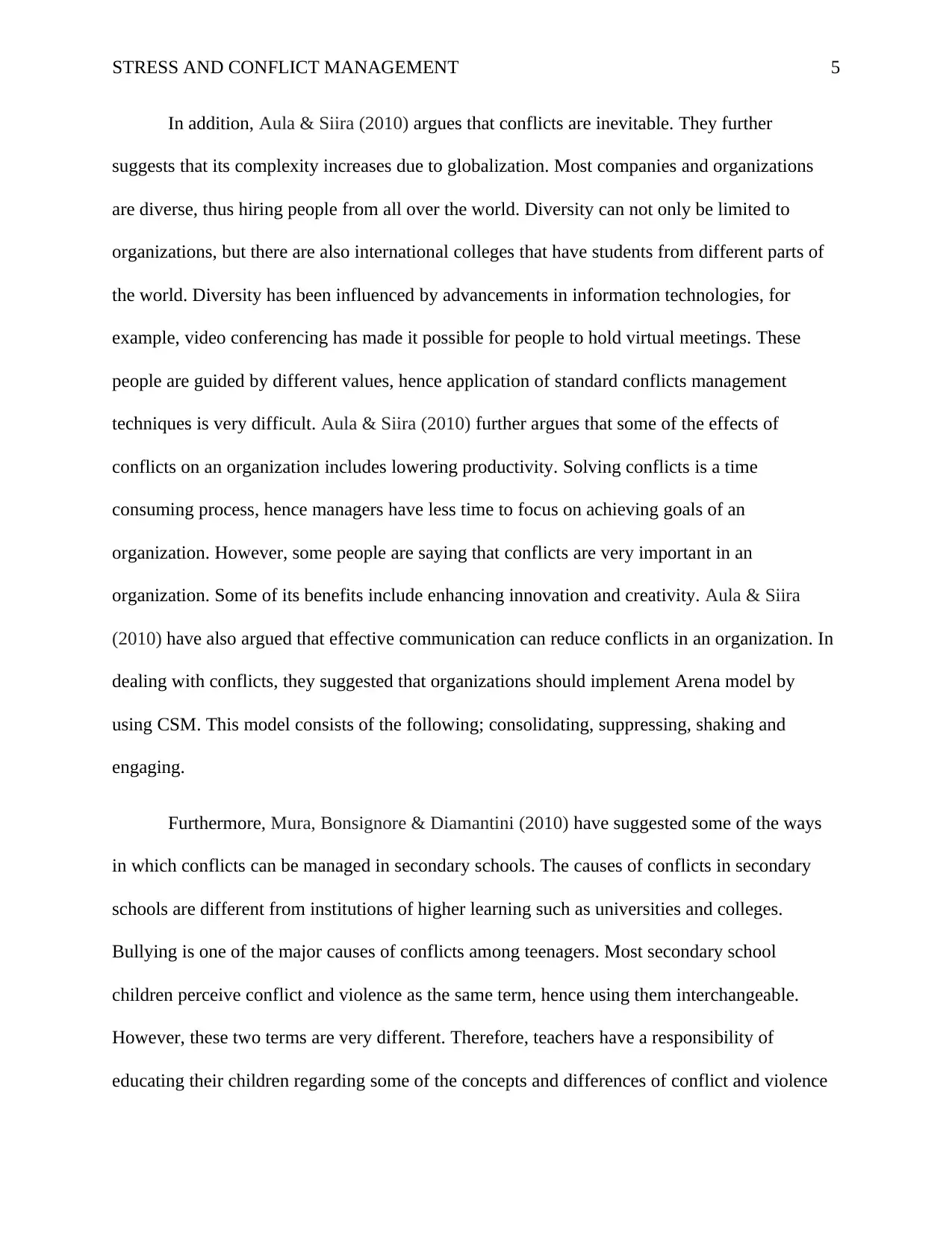
STRESS AND CONFLICT MANAGEMENT 5
In addition, Aula & Siira (2010) argues that conflicts are inevitable. They further
suggests that its complexity increases due to globalization. Most companies and organizations
are diverse, thus hiring people from all over the world. Diversity can not only be limited to
organizations, but there are also international colleges that have students from different parts of
the world. Diversity has been influenced by advancements in information technologies, for
example, video conferencing has made it possible for people to hold virtual meetings. These
people are guided by different values, hence application of standard conflicts management
techniques is very difficult. Aula & Siira (2010) further argues that some of the effects of
conflicts on an organization includes lowering productivity. Solving conflicts is a time
consuming process, hence managers have less time to focus on achieving goals of an
organization. However, some people are saying that conflicts are very important in an
organization. Some of its benefits include enhancing innovation and creativity. Aula & Siira
(2010) have also argued that effective communication can reduce conflicts in an organization. In
dealing with conflicts, they suggested that organizations should implement Arena model by
using CSM. This model consists of the following; consolidating, suppressing, shaking and
engaging.
Furthermore, Mura, Bonsignore & Diamantini (2010) have suggested some of the ways
in which conflicts can be managed in secondary schools. The causes of conflicts in secondary
schools are different from institutions of higher learning such as universities and colleges.
Bullying is one of the major causes of conflicts among teenagers. Most secondary school
children perceive conflict and violence as the same term, hence using them interchangeable.
However, these two terms are very different. Therefore, teachers have a responsibility of
educating their children regarding some of the concepts and differences of conflict and violence
In addition, Aula & Siira (2010) argues that conflicts are inevitable. They further
suggests that its complexity increases due to globalization. Most companies and organizations
are diverse, thus hiring people from all over the world. Diversity can not only be limited to
organizations, but there are also international colleges that have students from different parts of
the world. Diversity has been influenced by advancements in information technologies, for
example, video conferencing has made it possible for people to hold virtual meetings. These
people are guided by different values, hence application of standard conflicts management
techniques is very difficult. Aula & Siira (2010) further argues that some of the effects of
conflicts on an organization includes lowering productivity. Solving conflicts is a time
consuming process, hence managers have less time to focus on achieving goals of an
organization. However, some people are saying that conflicts are very important in an
organization. Some of its benefits include enhancing innovation and creativity. Aula & Siira
(2010) have also argued that effective communication can reduce conflicts in an organization. In
dealing with conflicts, they suggested that organizations should implement Arena model by
using CSM. This model consists of the following; consolidating, suppressing, shaking and
engaging.
Furthermore, Mura, Bonsignore & Diamantini (2010) have suggested some of the ways
in which conflicts can be managed in secondary schools. The causes of conflicts in secondary
schools are different from institutions of higher learning such as universities and colleges.
Bullying is one of the major causes of conflicts among teenagers. Most secondary school
children perceive conflict and violence as the same term, hence using them interchangeable.
However, these two terms are very different. Therefore, teachers have a responsibility of
educating their children regarding some of the concepts and differences of conflict and violence
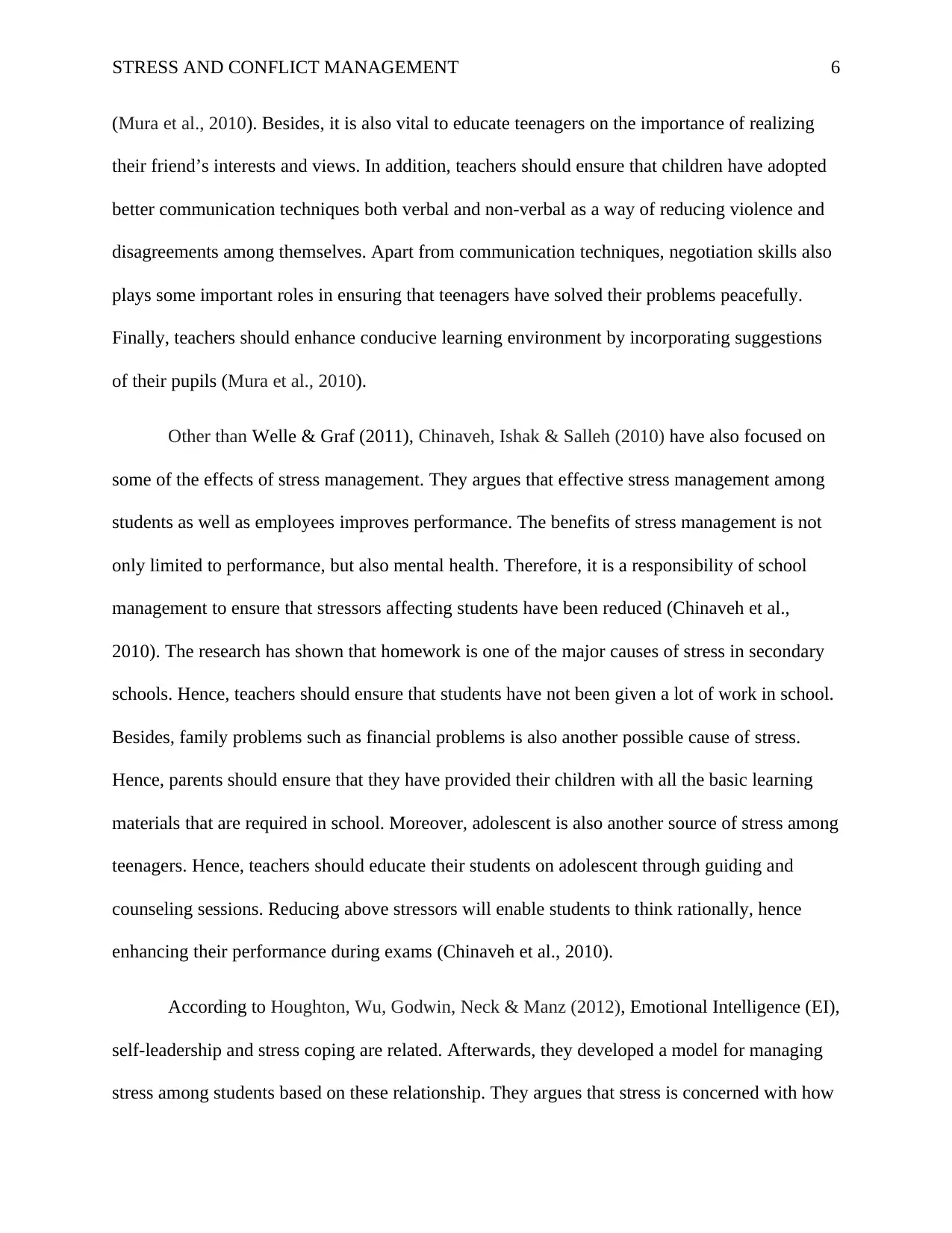
STRESS AND CONFLICT MANAGEMENT 6
(Mura et al., 2010). Besides, it is also vital to educate teenagers on the importance of realizing
their friend’s interests and views. In addition, teachers should ensure that children have adopted
better communication techniques both verbal and non-verbal as a way of reducing violence and
disagreements among themselves. Apart from communication techniques, negotiation skills also
plays some important roles in ensuring that teenagers have solved their problems peacefully.
Finally, teachers should enhance conducive learning environment by incorporating suggestions
of their pupils (Mura et al., 2010).
Other than Welle & Graf (2011), Chinaveh, Ishak & Salleh (2010) have also focused on
some of the effects of stress management. They argues that effective stress management among
students as well as employees improves performance. The benefits of stress management is not
only limited to performance, but also mental health. Therefore, it is a responsibility of school
management to ensure that stressors affecting students have been reduced (Chinaveh et al.,
2010). The research has shown that homework is one of the major causes of stress in secondary
schools. Hence, teachers should ensure that students have not been given a lot of work in school.
Besides, family problems such as financial problems is also another possible cause of stress.
Hence, parents should ensure that they have provided their children with all the basic learning
materials that are required in school. Moreover, adolescent is also another source of stress among
teenagers. Hence, teachers should educate their students on adolescent through guiding and
counseling sessions. Reducing above stressors will enable students to think rationally, hence
enhancing their performance during exams (Chinaveh et al., 2010).
According to Houghton, Wu, Godwin, Neck & Manz (2012), Emotional Intelligence (EI),
self-leadership and stress coping are related. Afterwards, they developed a model for managing
stress among students based on these relationship. They argues that stress is concerned with how
(Mura et al., 2010). Besides, it is also vital to educate teenagers on the importance of realizing
their friend’s interests and views. In addition, teachers should ensure that children have adopted
better communication techniques both verbal and non-verbal as a way of reducing violence and
disagreements among themselves. Apart from communication techniques, negotiation skills also
plays some important roles in ensuring that teenagers have solved their problems peacefully.
Finally, teachers should enhance conducive learning environment by incorporating suggestions
of their pupils (Mura et al., 2010).
Other than Welle & Graf (2011), Chinaveh, Ishak & Salleh (2010) have also focused on
some of the effects of stress management. They argues that effective stress management among
students as well as employees improves performance. The benefits of stress management is not
only limited to performance, but also mental health. Therefore, it is a responsibility of school
management to ensure that stressors affecting students have been reduced (Chinaveh et al.,
2010). The research has shown that homework is one of the major causes of stress in secondary
schools. Hence, teachers should ensure that students have not been given a lot of work in school.
Besides, family problems such as financial problems is also another possible cause of stress.
Hence, parents should ensure that they have provided their children with all the basic learning
materials that are required in school. Moreover, adolescent is also another source of stress among
teenagers. Hence, teachers should educate their students on adolescent through guiding and
counseling sessions. Reducing above stressors will enable students to think rationally, hence
enhancing their performance during exams (Chinaveh et al., 2010).
According to Houghton, Wu, Godwin, Neck & Manz (2012), Emotional Intelligence (EI),
self-leadership and stress coping are related. Afterwards, they developed a model for managing
stress among students based on these relationship. They argues that stress is concerned with how
⊘ This is a preview!⊘
Do you want full access?
Subscribe today to unlock all pages.

Trusted by 1+ million students worldwide
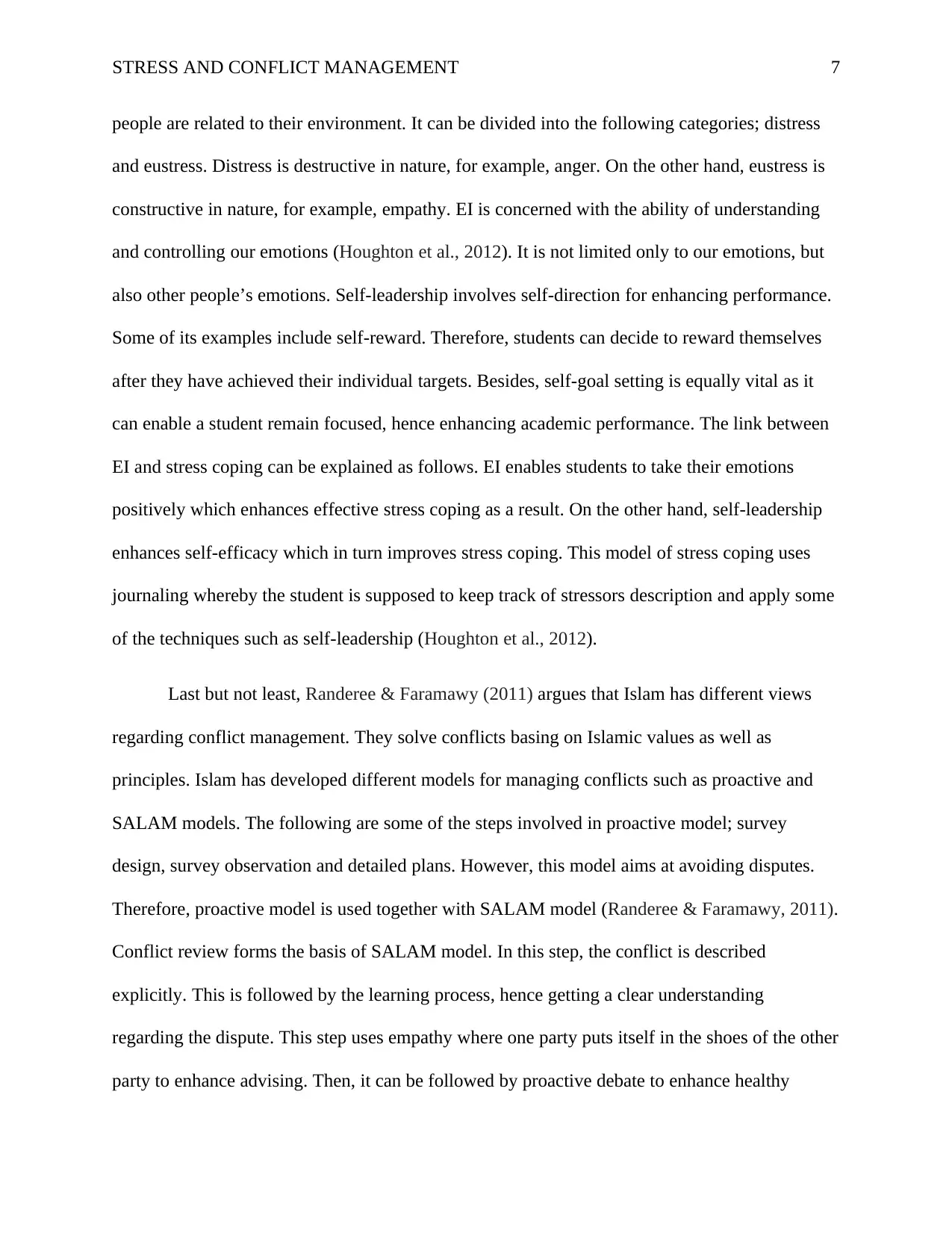
STRESS AND CONFLICT MANAGEMENT 7
people are related to their environment. It can be divided into the following categories; distress
and eustress. Distress is destructive in nature, for example, anger. On the other hand, eustress is
constructive in nature, for example, empathy. EI is concerned with the ability of understanding
and controlling our emotions (Houghton et al., 2012). It is not limited only to our emotions, but
also other people’s emotions. Self-leadership involves self-direction for enhancing performance.
Some of its examples include self-reward. Therefore, students can decide to reward themselves
after they have achieved their individual targets. Besides, self-goal setting is equally vital as it
can enable a student remain focused, hence enhancing academic performance. The link between
EI and stress coping can be explained as follows. EI enables students to take their emotions
positively which enhances effective stress coping as a result. On the other hand, self-leadership
enhances self-efficacy which in turn improves stress coping. This model of stress coping uses
journaling whereby the student is supposed to keep track of stressors description and apply some
of the techniques such as self-leadership (Houghton et al., 2012).
Last but not least, Randeree & Faramawy (2011) argues that Islam has different views
regarding conflict management. They solve conflicts basing on Islamic values as well as
principles. Islam has developed different models for managing conflicts such as proactive and
SALAM models. The following are some of the steps involved in proactive model; survey
design, survey observation and detailed plans. However, this model aims at avoiding disputes.
Therefore, proactive model is used together with SALAM model (Randeree & Faramawy, 2011).
Conflict review forms the basis of SALAM model. In this step, the conflict is described
explicitly. This is followed by the learning process, hence getting a clear understanding
regarding the dispute. This step uses empathy where one party puts itself in the shoes of the other
party to enhance advising. Then, it can be followed by proactive debate to enhance healthy
people are related to their environment. It can be divided into the following categories; distress
and eustress. Distress is destructive in nature, for example, anger. On the other hand, eustress is
constructive in nature, for example, empathy. EI is concerned with the ability of understanding
and controlling our emotions (Houghton et al., 2012). It is not limited only to our emotions, but
also other people’s emotions. Self-leadership involves self-direction for enhancing performance.
Some of its examples include self-reward. Therefore, students can decide to reward themselves
after they have achieved their individual targets. Besides, self-goal setting is equally vital as it
can enable a student remain focused, hence enhancing academic performance. The link between
EI and stress coping can be explained as follows. EI enables students to take their emotions
positively which enhances effective stress coping as a result. On the other hand, self-leadership
enhances self-efficacy which in turn improves stress coping. This model of stress coping uses
journaling whereby the student is supposed to keep track of stressors description and apply some
of the techniques such as self-leadership (Houghton et al., 2012).
Last but not least, Randeree & Faramawy (2011) argues that Islam has different views
regarding conflict management. They solve conflicts basing on Islamic values as well as
principles. Islam has developed different models for managing conflicts such as proactive and
SALAM models. The following are some of the steps involved in proactive model; survey
design, survey observation and detailed plans. However, this model aims at avoiding disputes.
Therefore, proactive model is used together with SALAM model (Randeree & Faramawy, 2011).
Conflict review forms the basis of SALAM model. In this step, the conflict is described
explicitly. This is followed by the learning process, hence getting a clear understanding
regarding the dispute. This step uses empathy where one party puts itself in the shoes of the other
party to enhance advising. Then, it can be followed by proactive debate to enhance healthy
Paraphrase This Document
Need a fresh take? Get an instant paraphrase of this document with our AI Paraphraser
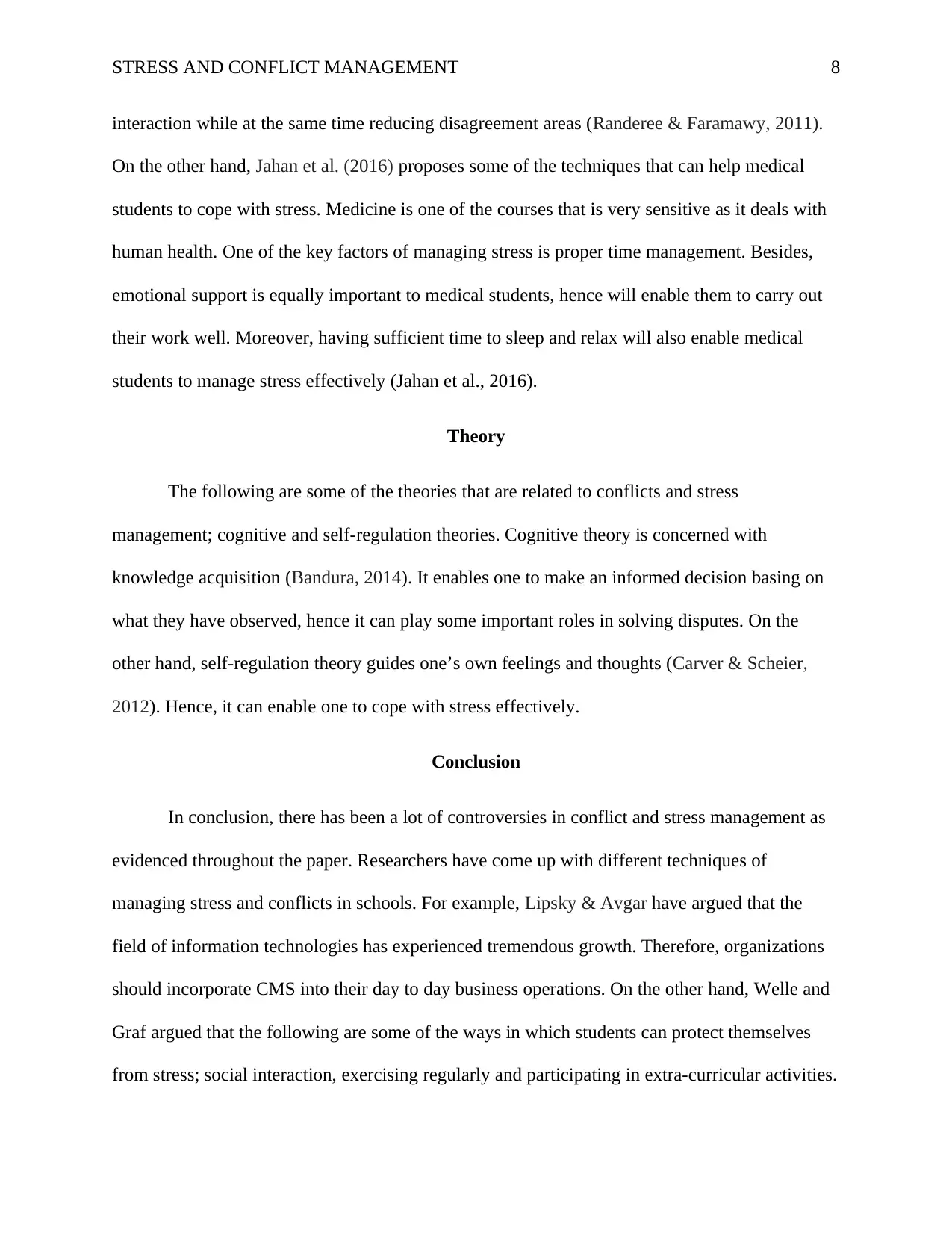
STRESS AND CONFLICT MANAGEMENT 8
interaction while at the same time reducing disagreement areas (Randeree & Faramawy, 2011).
On the other hand, Jahan et al. (2016) proposes some of the techniques that can help medical
students to cope with stress. Medicine is one of the courses that is very sensitive as it deals with
human health. One of the key factors of managing stress is proper time management. Besides,
emotional support is equally important to medical students, hence will enable them to carry out
their work well. Moreover, having sufficient time to sleep and relax will also enable medical
students to manage stress effectively (Jahan et al., 2016).
Theory
The following are some of the theories that are related to conflicts and stress
management; cognitive and self-regulation theories. Cognitive theory is concerned with
knowledge acquisition (Bandura, 2014). It enables one to make an informed decision basing on
what they have observed, hence it can play some important roles in solving disputes. On the
other hand, self-regulation theory guides one’s own feelings and thoughts (Carver & Scheier,
2012). Hence, it can enable one to cope with stress effectively.
Conclusion
In conclusion, there has been a lot of controversies in conflict and stress management as
evidenced throughout the paper. Researchers have come up with different techniques of
managing stress and conflicts in schools. For example, Lipsky & Avgar have argued that the
field of information technologies has experienced tremendous growth. Therefore, organizations
should incorporate CMS into their day to day business operations. On the other hand, Welle and
Graf argued that the following are some of the ways in which students can protect themselves
from stress; social interaction, exercising regularly and participating in extra-curricular activities.
interaction while at the same time reducing disagreement areas (Randeree & Faramawy, 2011).
On the other hand, Jahan et al. (2016) proposes some of the techniques that can help medical
students to cope with stress. Medicine is one of the courses that is very sensitive as it deals with
human health. One of the key factors of managing stress is proper time management. Besides,
emotional support is equally important to medical students, hence will enable them to carry out
their work well. Moreover, having sufficient time to sleep and relax will also enable medical
students to manage stress effectively (Jahan et al., 2016).
Theory
The following are some of the theories that are related to conflicts and stress
management; cognitive and self-regulation theories. Cognitive theory is concerned with
knowledge acquisition (Bandura, 2014). It enables one to make an informed decision basing on
what they have observed, hence it can play some important roles in solving disputes. On the
other hand, self-regulation theory guides one’s own feelings and thoughts (Carver & Scheier,
2012). Hence, it can enable one to cope with stress effectively.
Conclusion
In conclusion, there has been a lot of controversies in conflict and stress management as
evidenced throughout the paper. Researchers have come up with different techniques of
managing stress and conflicts in schools. For example, Lipsky & Avgar have argued that the
field of information technologies has experienced tremendous growth. Therefore, organizations
should incorporate CMS into their day to day business operations. On the other hand, Welle and
Graf argued that the following are some of the ways in which students can protect themselves
from stress; social interaction, exercising regularly and participating in extra-curricular activities.
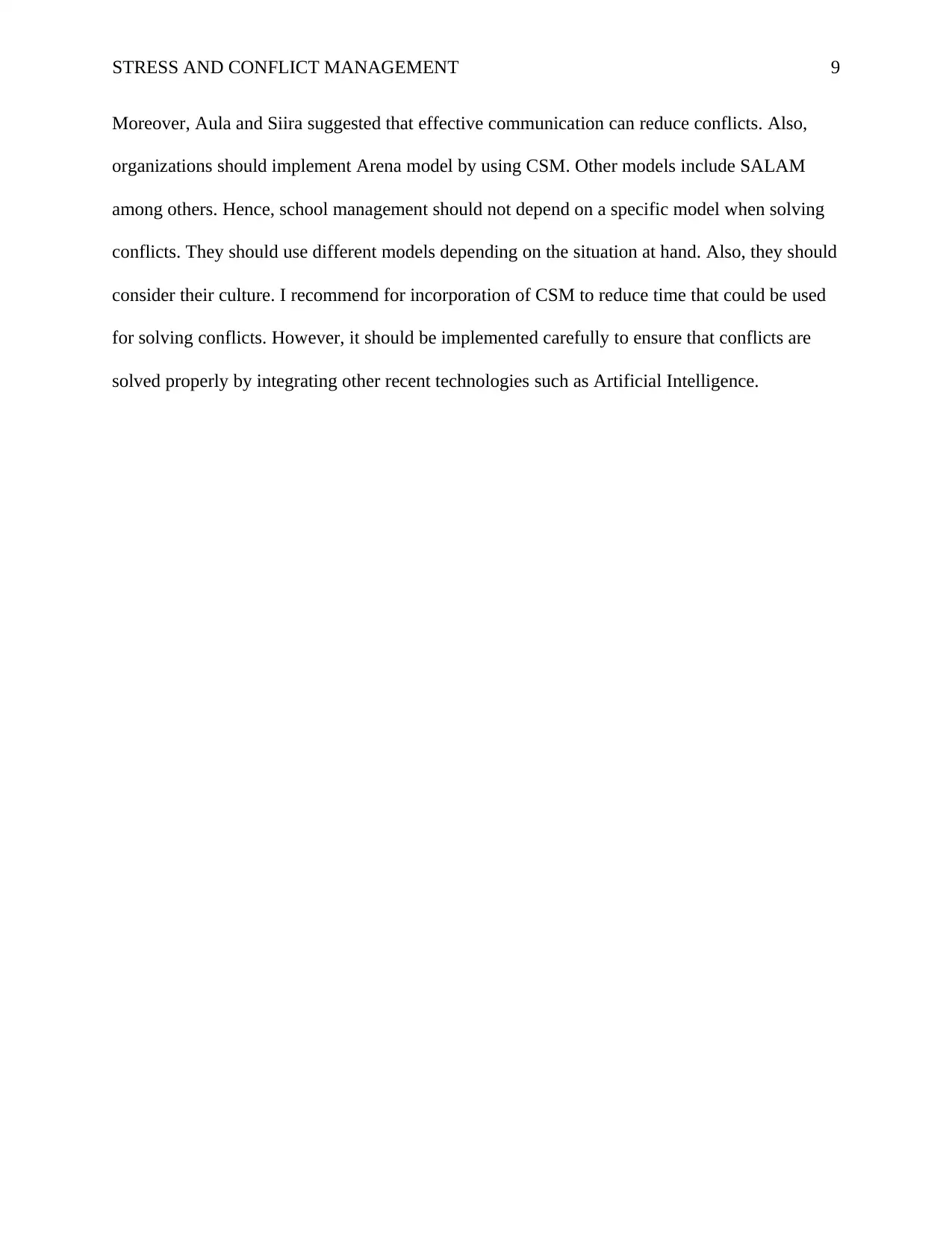
STRESS AND CONFLICT MANAGEMENT 9
Moreover, Aula and Siira suggested that effective communication can reduce conflicts. Also,
organizations should implement Arena model by using CSM. Other models include SALAM
among others. Hence, school management should not depend on a specific model when solving
conflicts. They should use different models depending on the situation at hand. Also, they should
consider their culture. I recommend for incorporation of CSM to reduce time that could be used
for solving conflicts. However, it should be implemented carefully to ensure that conflicts are
solved properly by integrating other recent technologies such as Artificial Intelligence.
Moreover, Aula and Siira suggested that effective communication can reduce conflicts. Also,
organizations should implement Arena model by using CSM. Other models include SALAM
among others. Hence, school management should not depend on a specific model when solving
conflicts. They should use different models depending on the situation at hand. Also, they should
consider their culture. I recommend for incorporation of CSM to reduce time that could be used
for solving conflicts. However, it should be implemented carefully to ensure that conflicts are
solved properly by integrating other recent technologies such as Artificial Intelligence.
⊘ This is a preview!⊘
Do you want full access?
Subscribe today to unlock all pages.

Trusted by 1+ million students worldwide
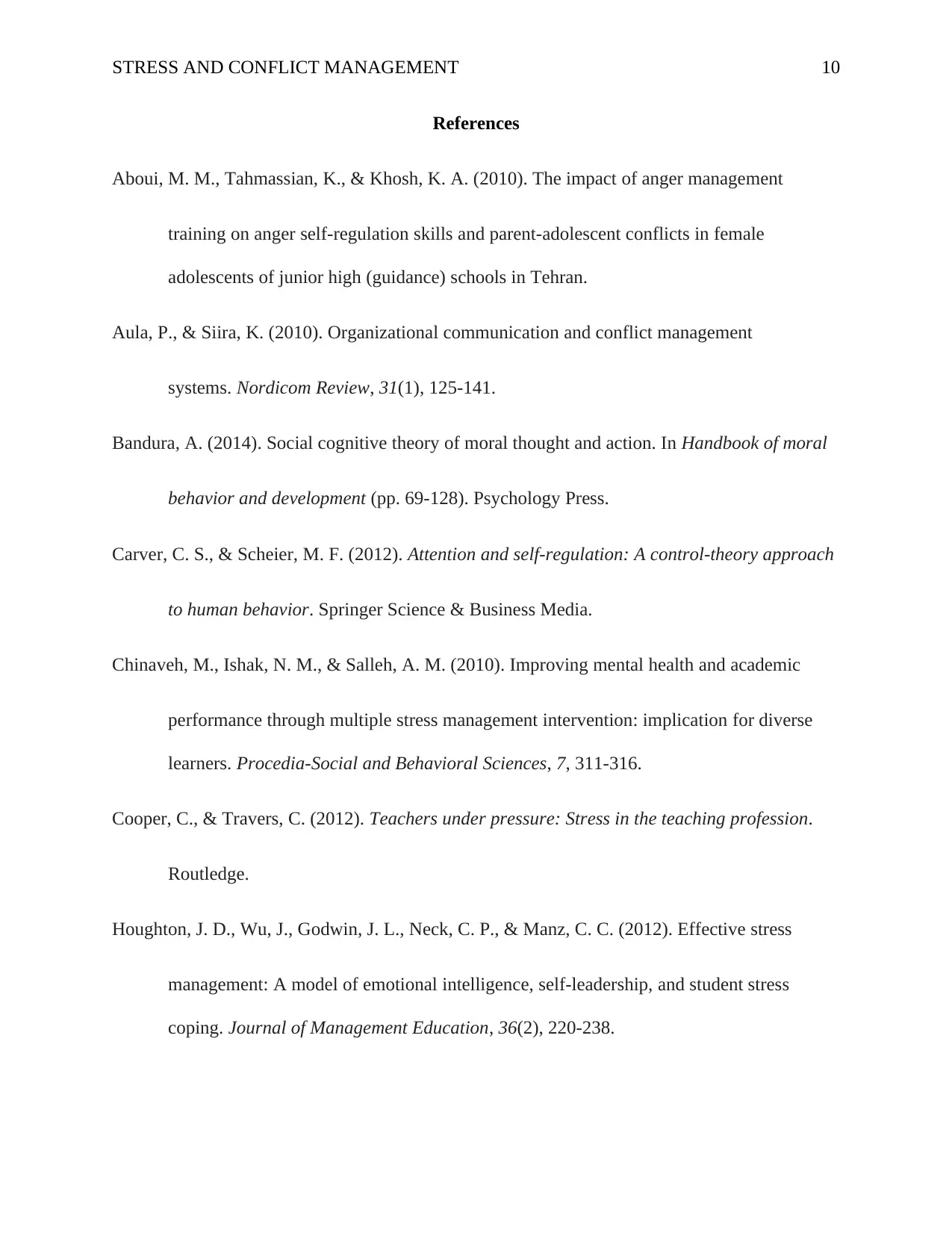
STRESS AND CONFLICT MANAGEMENT 10
References
Aboui, M. M., Tahmassian, K., & Khosh, K. A. (2010). The impact of anger management
training on anger self-regulation skills and parent-adolescent conflicts in female
adolescents of junior high (guidance) schools in Tehran.
Aula, P., & Siira, K. (2010). Organizational communication and conflict management
systems. Nordicom Review, 31(1), 125-141.
Bandura, A. (2014). Social cognitive theory of moral thought and action. In Handbook of moral
behavior and development (pp. 69-128). Psychology Press.
Carver, C. S., & Scheier, M. F. (2012). Attention and self-regulation: A control-theory approach
to human behavior. Springer Science & Business Media.
Chinaveh, M., Ishak, N. M., & Salleh, A. M. (2010). Improving mental health and academic
performance through multiple stress management intervention: implication for diverse
learners. Procedia-Social and Behavioral Sciences, 7, 311-316.
Cooper, C., & Travers, C. (2012). Teachers under pressure: Stress in the teaching profession.
Routledge.
Houghton, J. D., Wu, J., Godwin, J. L., Neck, C. P., & Manz, C. C. (2012). Effective stress
management: A model of emotional intelligence, self-leadership, and student stress
coping. Journal of Management Education, 36(2), 220-238.
References
Aboui, M. M., Tahmassian, K., & Khosh, K. A. (2010). The impact of anger management
training on anger self-regulation skills and parent-adolescent conflicts in female
adolescents of junior high (guidance) schools in Tehran.
Aula, P., & Siira, K. (2010). Organizational communication and conflict management
systems. Nordicom Review, 31(1), 125-141.
Bandura, A. (2014). Social cognitive theory of moral thought and action. In Handbook of moral
behavior and development (pp. 69-128). Psychology Press.
Carver, C. S., & Scheier, M. F. (2012). Attention and self-regulation: A control-theory approach
to human behavior. Springer Science & Business Media.
Chinaveh, M., Ishak, N. M., & Salleh, A. M. (2010). Improving mental health and academic
performance through multiple stress management intervention: implication for diverse
learners. Procedia-Social and Behavioral Sciences, 7, 311-316.
Cooper, C., & Travers, C. (2012). Teachers under pressure: Stress in the teaching profession.
Routledge.
Houghton, J. D., Wu, J., Godwin, J. L., Neck, C. P., & Manz, C. C. (2012). Effective stress
management: A model of emotional intelligence, self-leadership, and student stress
coping. Journal of Management Education, 36(2), 220-238.
Paraphrase This Document
Need a fresh take? Get an instant paraphrase of this document with our AI Paraphraser
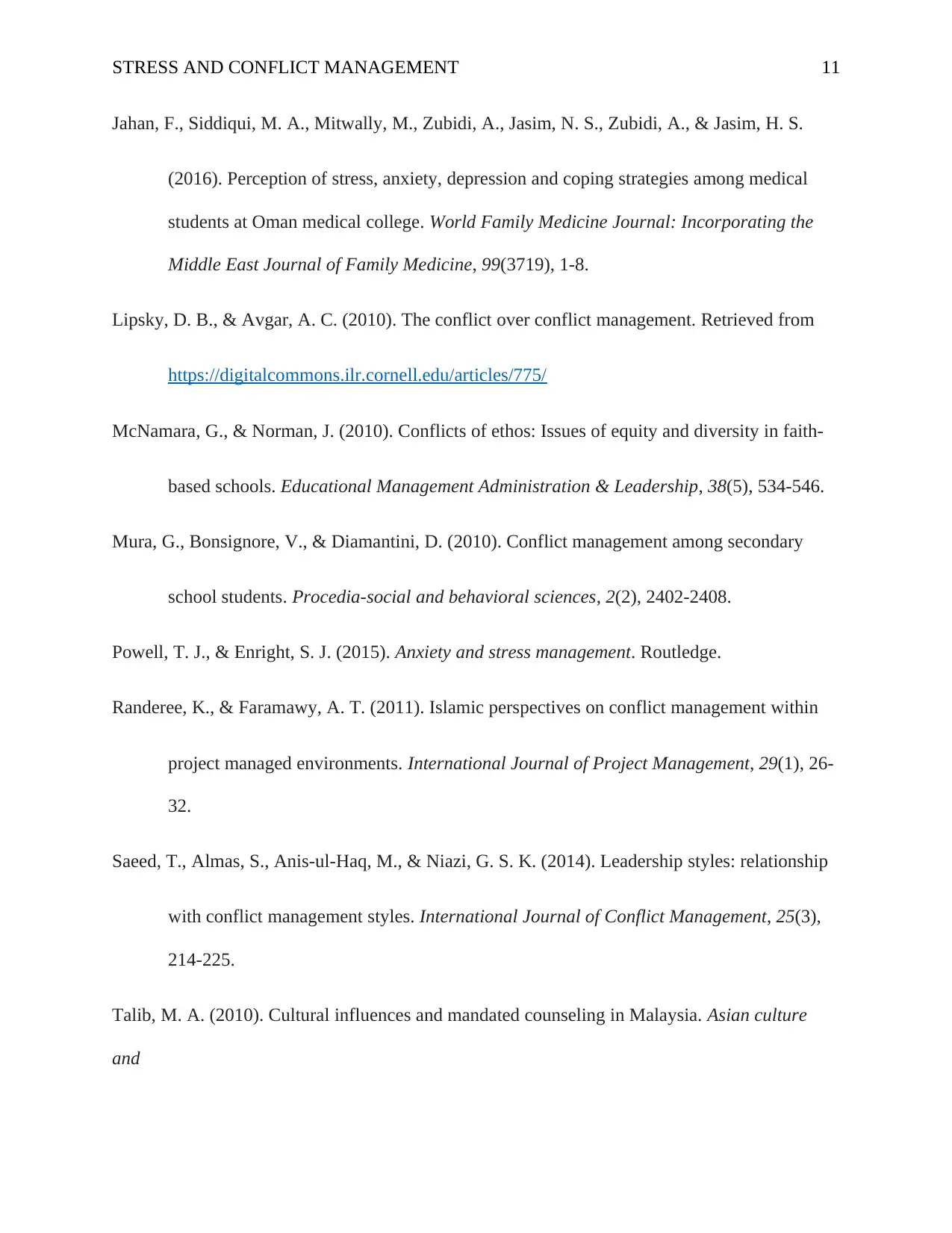
STRESS AND CONFLICT MANAGEMENT 11
Jahan, F., Siddiqui, M. A., Mitwally, M., Zubidi, A., Jasim, N. S., Zubidi, A., & Jasim, H. S.
(2016). Perception of stress, anxiety, depression and coping strategies among medical
students at Oman medical college. World Family Medicine Journal: Incorporating the
Middle East Journal of Family Medicine, 99(3719), 1-8.
Lipsky, D. B., & Avgar, A. C. (2010). The conflict over conflict management. Retrieved from
https://digitalcommons.ilr.cornell.edu/articles/775/
McNamara, G., & Norman, J. (2010). Conflicts of ethos: Issues of equity and diversity in faith-
based schools. Educational Management Administration & Leadership, 38(5), 534-546.
Mura, G., Bonsignore, V., & Diamantini, D. (2010). Conflict management among secondary
school students. Procedia-social and behavioral sciences, 2(2), 2402-2408.
Powell, T. J., & Enright, S. J. (2015). Anxiety and stress management. Routledge.
Randeree, K., & Faramawy, A. T. (2011). Islamic perspectives on conflict management within
project managed environments. International Journal of Project Management, 29(1), 26-
32.
Saeed, T., Almas, S., Anis-ul-Haq, M., & Niazi, G. S. K. (2014). Leadership styles: relationship
with conflict management styles. International Journal of Conflict Management, 25(3),
214-225.
Talib, M. A. (2010). Cultural influences and mandated counseling in Malaysia. Asian culture
and
Jahan, F., Siddiqui, M. A., Mitwally, M., Zubidi, A., Jasim, N. S., Zubidi, A., & Jasim, H. S.
(2016). Perception of stress, anxiety, depression and coping strategies among medical
students at Oman medical college. World Family Medicine Journal: Incorporating the
Middle East Journal of Family Medicine, 99(3719), 1-8.
Lipsky, D. B., & Avgar, A. C. (2010). The conflict over conflict management. Retrieved from
https://digitalcommons.ilr.cornell.edu/articles/775/
McNamara, G., & Norman, J. (2010). Conflicts of ethos: Issues of equity and diversity in faith-
based schools. Educational Management Administration & Leadership, 38(5), 534-546.
Mura, G., Bonsignore, V., & Diamantini, D. (2010). Conflict management among secondary
school students. Procedia-social and behavioral sciences, 2(2), 2402-2408.
Powell, T. J., & Enright, S. J. (2015). Anxiety and stress management. Routledge.
Randeree, K., & Faramawy, A. T. (2011). Islamic perspectives on conflict management within
project managed environments. International Journal of Project Management, 29(1), 26-
32.
Saeed, T., Almas, S., Anis-ul-Haq, M., & Niazi, G. S. K. (2014). Leadership styles: relationship
with conflict management styles. International Journal of Conflict Management, 25(3),
214-225.
Talib, M. A. (2010). Cultural influences and mandated counseling in Malaysia. Asian culture
and
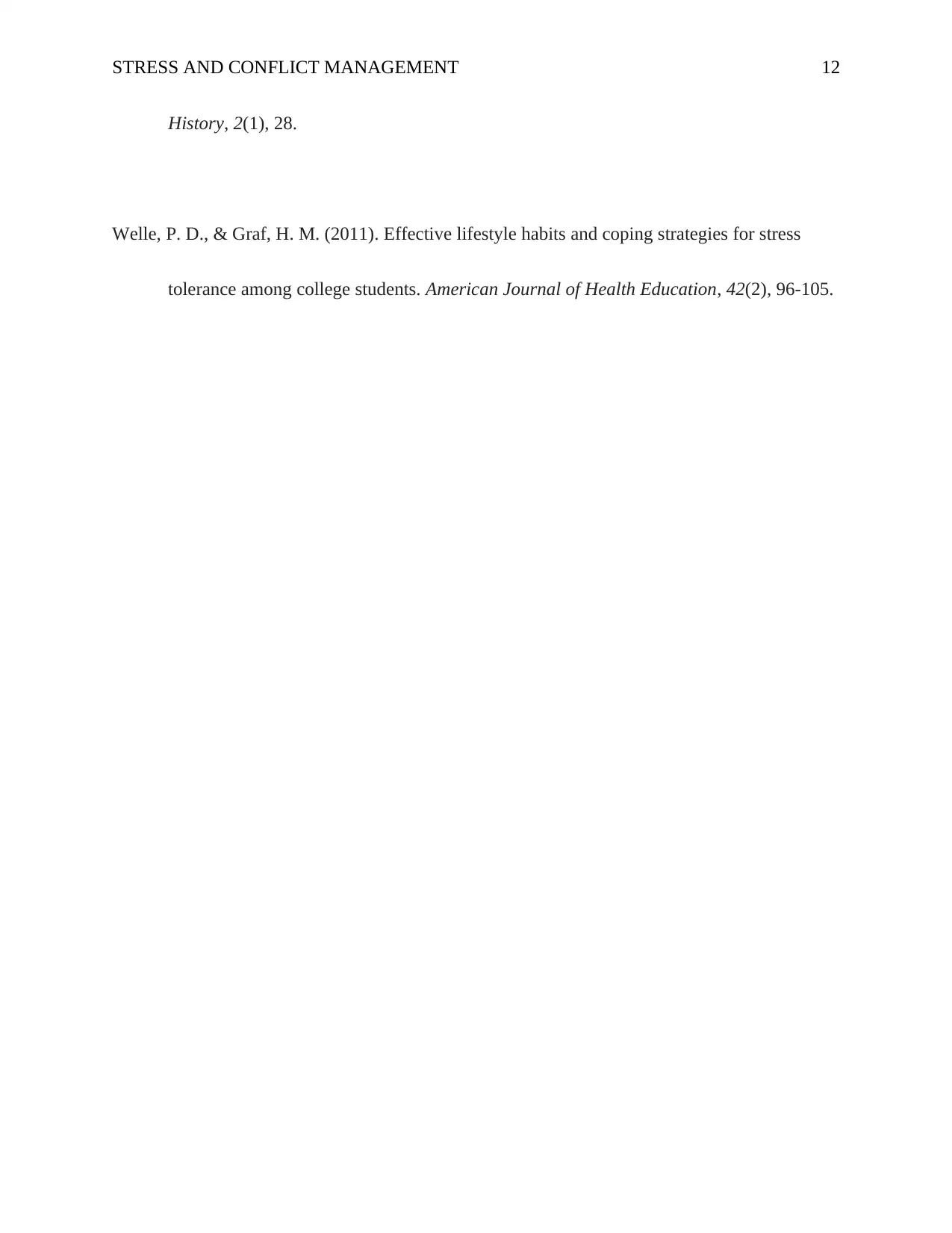
STRESS AND CONFLICT MANAGEMENT 12
History, 2(1), 28.
Welle, P. D., & Graf, H. M. (2011). Effective lifestyle habits and coping strategies for stress
tolerance among college students. American Journal of Health Education, 42(2), 96-105.
History, 2(1), 28.
Welle, P. D., & Graf, H. M. (2011). Effective lifestyle habits and coping strategies for stress
tolerance among college students. American Journal of Health Education, 42(2), 96-105.
⊘ This is a preview!⊘
Do you want full access?
Subscribe today to unlock all pages.

Trusted by 1+ million students worldwide
1 out of 13
Related Documents
Your All-in-One AI-Powered Toolkit for Academic Success.
+13062052269
info@desklib.com
Available 24*7 on WhatsApp / Email
![[object Object]](/_next/static/media/star-bottom.7253800d.svg)
Unlock your academic potential
Copyright © 2020–2025 A2Z Services. All Rights Reserved. Developed and managed by ZUCOL.




